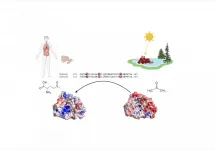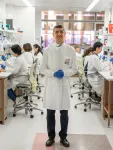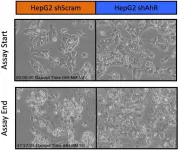Tiny amino acid differences can lead to dramatically different enzymes
2021-05-11
(Press-News.org) Just a few changes to an enzyme's amino acids can be enough to dramatically change its function, enabling microbes to inhabit wildly different environments.
University of Queensland microbiologist Associate Professor Ulrike Kappler, led by an international team of researchers, made this discovery when investigating how Haemophilus influenzae bacteria colonise the human respiratory system.
"This disease-causing bacterium is supremely adapted to living in humans, so much so that they cannot survive anywhere else," Dr Kappler said.
"It turns out that one enzyme, MtsZ, is the key player in this adaptation.
"But, surprisingly, close relatives of this protein, which promotes Haemophilus survival exclusively inside humans, help other species of bacteria to survive exclusively in lakes.
"How could closely related enzymes help one bacterial species live exclusively in humans and another to live only in lakes?
"The answer is a matter of minute amino acid changes."
The research shows that a sequence difference of just three amino acids, a difference of less than 0.25 per cent of the MtsZ enzyme sequence, changes the functionality of the enzyme between bacteria living in lakes compared with those living in humans.
"It the natural world, tiny differences can lead to enormous functional changes - for example, humans and chimpanzees aren't exactly the same despite being 99 percent genetically similar," Dr Kappler said.
"We're just now realising that this can be the case for enzymes as well.
"The slight changes in this enzyme enable the lake-dwelling bacteria to live on decaying algae and generate energy.
"Contrast this with Haemophilus, which uses MtsZ to scavenge amino acids from the human body and use them for bacterial growth and replication.
"Now that we understand the unique structure of this enzyme in Haemophilus, we hope to develop ways to inhibit its specific function and remedy chronic respiratory conditions associated with this bacterium."
INFORMATION:
The paper is published in Journal of Biological Chemistry (DOI: 10.1016/j.jbc.2021.100672) and includes collaborating researchers from the USA, Germany and Australia.
[Attachments] See images for this press release:

ELSE PRESS RELEASES FROM THIS DATE:
2021-05-11
Researchers have been able to reduce scarring by blocking part of the healing process in research that could make a significant difference for burns and other trauma patients.
University of Queensland Professor Kiarash Khosrotehrani said scars had been reduced by targeting the gene that instructs stem cells to form them in an animal study.
"The body's natural response to trauma is to make plenty of blood vessels to take oxygen and nutrients to the wound to repair it," Professor Khosrotehrani said.
"Once the wound has closed, many of these blood vessels become fibroblast cells which produce the collagens forming the hard materials found in scar tissue.
"We found that vascular stem cells determined whether a blood vessel was retained or gave rise to scar material ...
2021-05-11
CORVALLIS, Ore. - A team of Oregon State University scientists has discovered a new class of anti-cancer compounds that effectively kill liver and breast cancer cells.
The findings, recently published in the journal Apoptosis, describe the discovery and characterization of compounds, designated as Select Modulators of AhR-regulated Transcription (SMAhRTs).
Edmond Francis O'Donnell III and a team of OSU researchers conducted the research in the laboratory of Siva Kolluri, a professor of cancer research at Oregon State. They also identified the aryl hydrocarbon receptor (AhR) as a new molecular target ...
2021-05-11
Researchers looking to help people suffering from addiction, depression, and pain are studying how certain brain neurons operate to see if they can be controlled.
In a paper published May 11 in Neuron, researchers at the University of Washington School of Medicine and Washington University in St. Louis, along with several other universities, successfully used a protein called parapinopsin to turn off brain circuits. This protein is found in lamprey - an ancient lineage of jawless fish similar to eel. Reserachers said the ability to inhibit neurons could eventually lead to turning ...
2021-05-11
BUFFALO, N.Y. - Americans are in chronic pain, and a comprehensive new study exploring trends in this major public health concern reveals that what has been a long-standing and under-acknowledged problem is getting substantially worse.
The findings, published in the latest issue of the journal Demography, suggest blanket increases across multiple measures, with pain rising in every adult age group, in every demographic group, and at every site of pain for which data exists. People today are experiencing more pain than individuals of the same age in earlier decades. In fact, each subsequent birth group is in greater pain than the one that came before it.
"We ...
2021-05-11
BOSTON - It's a real-life plot worthy of a classic spy novel: Researchers at Massachusetts General Hospital (MGH), the Dana-Farber Cancer Institute and other Boston-area research centers are turning the tables on glioblastomas, the most devastating and aggressive form of brain cancer, by transforming a type of cell that normally protects tumors and inhibits effective drug therapy into a stone-cold glioblastoma killer.
Glioblastoma, a type of brain tumor, is rapidly fatal: Most patients die within two years of diagnosis despite aggressive therapies such as brain surgery, whole-brain radiation and chemotherapy.
Despite hopes that a class of drugs known as immune checkpoint blockers (ICBs) - drugs that have revolutionized the treatment ...
2021-05-11
DURHAM, N.C. -- With mosquito season upon us, people are stocking up on repellents to prevent itchy bites. Bug repellents are important because they don't just protect against the buzzing, blood-sucking little pests -- they also safeguard against the diseases they carry, which kill some 700,000 people worldwide each year.
Surprisingly, despite widespread use, no one understood exactly how most mosquito repellents keep the insects away. Now researchers are starting to uncover the first pieces of the puzzle.
A new study has identified a scent receptor in mosquitoes that helps them sniff out and avoid trace amounts of pyrethrum, a plant extract used for centuries to repel biting insects.
One ...
2021-05-11
INFORMS Journal Manufacturing & Service Operations Management Study Key Takeaways:
The study looked at archival data on 240 U.S. federal government technology programs across 24 federal agencies.
Researchers found that the practice of moving baseline targets is a key driver in continually increasing budgets for federal government technology programs.
The componentization of a program into smaller work units and increasing the level of competency in program management can dampen this increase, resulting in significant cost savings.
CATONSVILLE, MD, May 11, 2021 ...
2021-05-11
HERSHEY, Pa. -- Over the past year, studies have revealed that certain pre-existing conditions, such as cancer, diabetes and high blood pressure, can increase a person's risk of dying from COVID-19. New research shows that individuals living with human immunodeficiency virus (HIV) and acquired immune deficiency syndrome (AIDS) -- an estimated 38 million worldwide, according to the World Health Organization -- have an increased risk of SARS-CoV-2 infection and fatal outcomes from COVID-19.
In a new study, published in Scientific Reports, Penn State College of Medicine researchers found that people living ...
2021-05-11
A newly described horned dinosaur that lived in New Mexico 82 million years ago is one of the earliest known ceratopsid species, a group known as horned or frilled dinosaurs. Researchers reported their find in a publication in the journal PalZ (Paläontologische Zeitschrift).
Menefeeceratops sealeyi adds important information to scientists' understanding of the evolution of ceratopsid dinosaurs, which are characterized by horns and frills, along with beaked faces. In particular, the discovery sheds light on the centrosaurine subfamily of horned dinosaurs, of which Menefeeceratops is believed to be the oldest member. Its remains offer a clearer picture of the group's evolutionary path ...
2021-05-11
Researchers have developed a global earthquake monitoring system that uses the Global Navigational Satellite System (GNSS) to measure crustal deformation.
The monitoring system within seconds can rapidly assess earthquake magnitude and fault slip distribution for earthquakes of magnitude 7.0 and larger, making it a potentially valuable tool in earthquake and tsunami early warning for these damaging events, Central Washington University geophysicist Timothy Melbourne and colleagues report in the Bulletin of the Seismological Society of America.
GNSS can potentially characterize a large earthquake much more rapidly than the global seismic network, ...
LAST 30 PRESS RELEASES:
[Press-News.org] Tiny amino acid differences can lead to dramatically different enzymes




